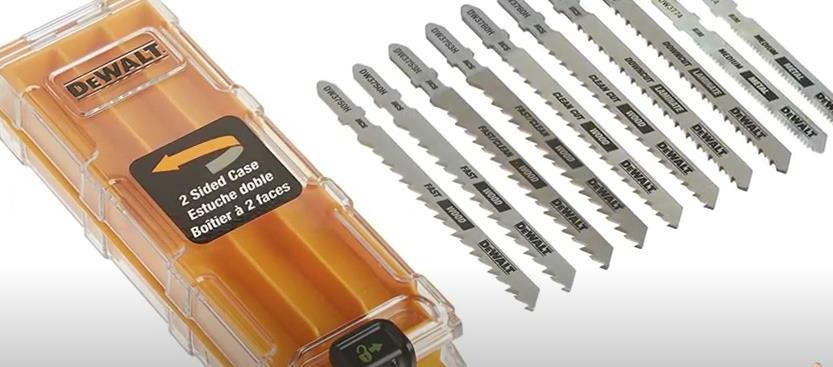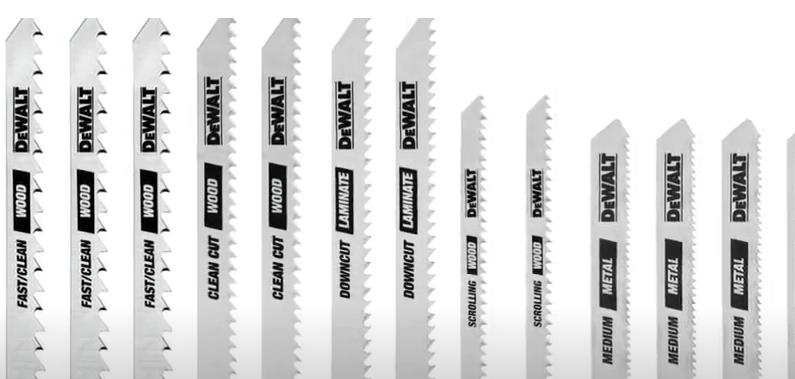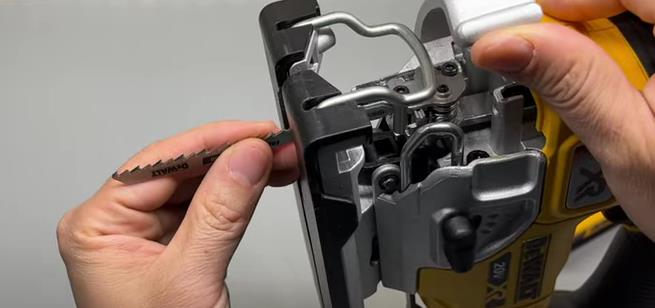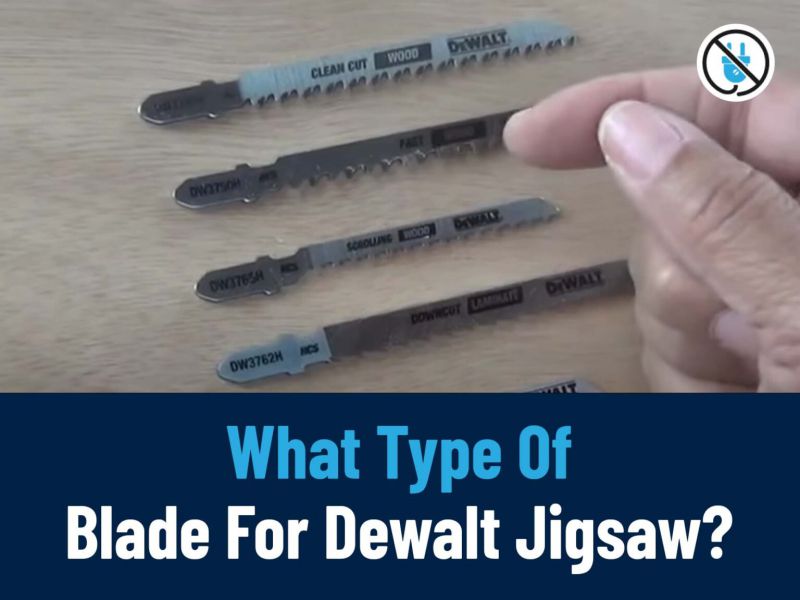A T-shank blade is the most common type of blade for a DeWalt jigsaw.
When it comes to using a jigsaw, the type of blade you use can make a big difference in the quality of your cuts and the overall performance of your tool.
If you’re a Dewalt jigsaw user, it’s important to understand the different types of blades available. So you need to know what type of blade for Dewalt jigsaw is perfect for your needs.
There are a few different types of blades that can be used with a DeWalt jigsaw, including a standard blade, a U-shank blade, and a T-shank blade. The standard blade is the most common type of blade and is compatible with most jigsaw models.
The U-shank blade is designed for use with models that have a U-shaped slot in the blade holder, while the T-shank blade is designed for use with models that have a T-shaped slot in the blade holder.
Yet, this guide will take a closer look at the different types of blades for Dewalt jigsaws. Here I will also cover how to choose the right blade for the job, and how to use Dewalt jigsaw blades safely and effectively.
Let’s get started.
What Type Of Blade For Dewalt Jigsaw?
The best blade type for a Dewalt jigsaw is the T-shank blade.

There are a few different types of blades that can be used on a Dewalt jigsaw.
let’s check out several types of blades available for use with a Dewalt jigsaw, like:
T-Shank blades:
These are the typical large jigsaw blade and are designed to fit into the T-shaped slot on most jigsaws. T-shank blades are known for their strong grip and stability, making them ideal for cutting wood, metal, and plastic.
U-Shank blades:
These blades have a U-shaped slot and are commonly utilized in older or less common jigsaw models. They are less common than T-shank blades, but can still be used for similar materials.
Reverse-Tooth blades:
These blades have teeth that point towards the back of the blade, which helps to minimize tear-out when cutting wood. They are great for making fine and smooth cuts.
Clean-Cut blades:
These blades have a special design that allows for smooth and clean cuts in wood, metal, and plastic. They are ideal for use in laminate and veneer cutting.
Metal blades:
These blades are designed specifically for cutting metal and are made from high-speed steel or bi-metal construction.
Standard Wood Cutting blades:
These blades are designed specifically for cutting wood and have a large number of teeth that are sharpened to a fine point. They are great for making fine cuts in wood.
Combination blade:
This type of blade is designed to be able to cut both metal and wood. The teeth on these blades are not as sharp as the metal-cutting blades, but they are sharp enough to cut through most types of wood. These blades are a good choice if you are going to be doing a lot of different types of cuts with your jigsaw.
However, it is important to ensure that the blade you choose is compatible with your Dewalt jigsaw model and the material you will be cutting.
So far, we know what type of Dewalt jigsaw blade.
However, you must decide which one is best for the job at hand. If you are only going to be making simple cuts on wood, you will probably be fine with a standard wood-cutting blade.
If you are going to be doing a lot of different types of cuts, you will want to use a combination blade. And if you are going to be doing a lot of metal cutting, then you will want to use a metal cutting blade.
What Are The Different Types Of Blades Available For A Dewalt Jigsaw?
There are four different types of blades available for a Dewalt jigsaw: T-shank, U-shank, plain-end, and specialty.
Choosing the Right Dewalt Jigsaw Blade For The Job
Jigsaw blades come in different shapes and sizes, each designed for a specific type of material.

When choosing a jigsaw blade, it is important to consider some things like
The Type Of Material
If you are cutting metal, you will need a different type of blade than if you are cutting wood. The thickness of the material you are cutting will also affect the type of blade you need. Thicker materials require a heavier-duty blade, while thinner materials can be cut with a standard blade.
The Number Of Teeth
The number of teeth on the blade will affect the quality of the cut. A blade with more teeth will produce a finer cut, while a blade with fewer teeth will produce a rougher cut. The type of material you are cutting will also affect the number of teeth you need. Softer materials, like wood, require fewer teeth, while harder materials, like metal, require more teeth.
Length of Blade
The length of the blade is another important consideration. Shorter blades are better for making tight turns, while longer blades are better for making straight cuts. The length of the blade will also affect the depth of the cut. Longer blades can make deeper cuts, while shorter blades are better for shallow cuts.
Shape of Blade
Finally, the shape of the blade is important for making different types of cuts. The two most common shapes are the straight blade and the spiral blade. The straight blade is good for making straight cuts, while the spiral blade is better for making curved cuts.
How To Use Dewalt Jigsaw Blades?

Here I will share step by step of use, Dewalt Jigsaw Blades.
Step-1. Installing the blade
- Make sure the jigsaw is unplugged and the battery is removed if it’s a cordless model.
- Open the blade clamp by releasing the lock and sliding it down, revealing the blade.
- Remove the old blade by gently pulling it out of the clamp.
- Ensure the teeth of the new blade face the correct direction and that the blade is firmly locked into the clamp.
- Slide the blade clamp back up and lock it in place to close it.
- Plug in the jigsaw or reinsert the battery if it’s cordless.
- Jigsaw blades should be tight and secure before starting.
step-2. Adjusting the speed and pressure
- Some Dewalt jigsaws have a variable speed trigger that allows blade speed to be adjusted.
- The speed of the jigsaw can be adjusted by using the speed control dial or trigger.
- The pressure exerted on the blade can be adjusted by using the shoe plate or base plate, which can be moved up or down to adjust the angle of the blade.
Step-3. Safety precautions
- A dust mask and safety goggles are always recommended when using a jigsaw.
- Hold the jigsaw securely and guide it along the cutting line while keeping the blade on the material.
- Keep your hands and fingers away from the blade at all times.
- Unplug the jigsaw or remove the battery when not in use or when changing the blade.
- Jigsaws should always be used according to the manufacturer’s instructions and safety guidelines.
FAQ- What Type Of Blade For Dewalt Jigsaw
What Are The Advantages And Disadvantages Of Each Type Of Blade For A Dewalt Jigsaw?
The main advantage of a T-shank blade is that it is more versatile and can be used with a wider range of jigsaw models. The main disadvantage of a T-shank blade is that it is not as secure as a U-shank blade and can come loose more easily.
The main advantage of a U-shank blade is that it is more secure and less likely to come loose. The main disadvantage of a U-shank blade is that it is less versatile and can only be used with certain jigsaw models.
What Are Some Tips For Choosing The Right Blade Type For A Dewalt Jigsaw?
Conclusion
A blade for a Dewalt jigsaw is an important part of the tool, and it is important to get one that will last.
If you’re looking for a good Dewalt jigsaw blade, there are a few different types to consider. The standard blade is great for general use, but might not be the best option if you need to cut really tough materials.
An extra-wide blade is perfect for cutting through tougher material, while a thin blade is best suited for precise tasks.
Regardless of what type of blade to use Dewalt jigsaw you choose, make sure to read the user manual carefully before using your machine in order to avoid any accidents.
If you still have questions about what type of blade for Dewalt jigsaw, feel free to leave a comment below.


5 thoughts on “What Type Of Blade For Dewalt Jigsaw? Reveal The Secret True”
Comments are closed.